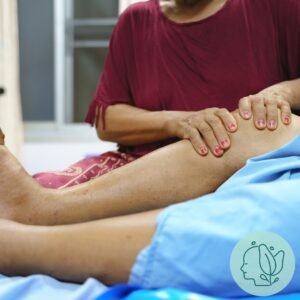Oedema therapy: relief from swelling and fluid accumulation
Oedema, or fluid accumulation, can cause a heavy, painful or tense feeling in arms, legs or other parts of the body. The cause varies: from lymphatic disturbances to venous problems or as a side effect of medical treatments such as cancer therapy. Oedema therapy is a specialised form of physiotherapy aimed at reducing these symptoms and preventing recurrent swelling.

What is oedema?
With oedema, fluid accumulates in the tissue, often visible as swelling. This can result from poor drainage of lymph fluid (lymphoedema) or disturbed blood circulation (venous oedema). People with oedema often experience:
- Heavy, tired arms or legs
- Tight skin or feeling tense
- Limited mobility
- Pain or a nagging feeling, especially at the end of the day
Long-term oedema without treatment can lead to hardening of the tissue (fibrosis) and increased risk of infections, such as wound erosion. Lifestyle also plays a role: oedema is more common in people who are overweight or who do not exercise much. Reduced muscle activity and increased pressure on vessels and lymphatic pathways cause fluid drainage to become more rapidly impaired.
How does oedema therapy work?
Oedema therapy is usually started after referral from a doctor, as the underlying cause must first be ruled out or treated. Consider, for example, heart, kidney or liver problems. Once the cause is known, the oedema therapist can start a personalised treatment plan.
Depending on the type and severity of the oedema, therapy consists of a combination of techniques:
- Manual lymph drainage: a gentle form of massage that stimulates lymphatic drainage
- Compression therapy: bandages or therapeutic stockings to combat fluid accumulation
- Exercise therapy: movement promotes circulation and supports fluid drainage
- Lymph taping: special tape supports skin function and stimulates lymph flow
- Self-care advice: how to reduce symptoms yourself, e.g. with skin care or posture advice
This multidisciplinary approach is proven to be effective. According to a review study in Journal of Physiotherapy (2017), oedema therapy not only reduces fluid volume, but also improves patients' quality of life and mobility.
Case study
Anne suffered from a swollen arm after breast cancer. Her doctor referred her to an oedema therapist. After several weeks of manual lymph drainage combined with compression and home exercises, she noticed that the swelling went down and she could use her arm normally again. Thanks to the self-care advice, she now also knows how to prevent symptoms, for instance by avoiding overexertion and exercising enough.